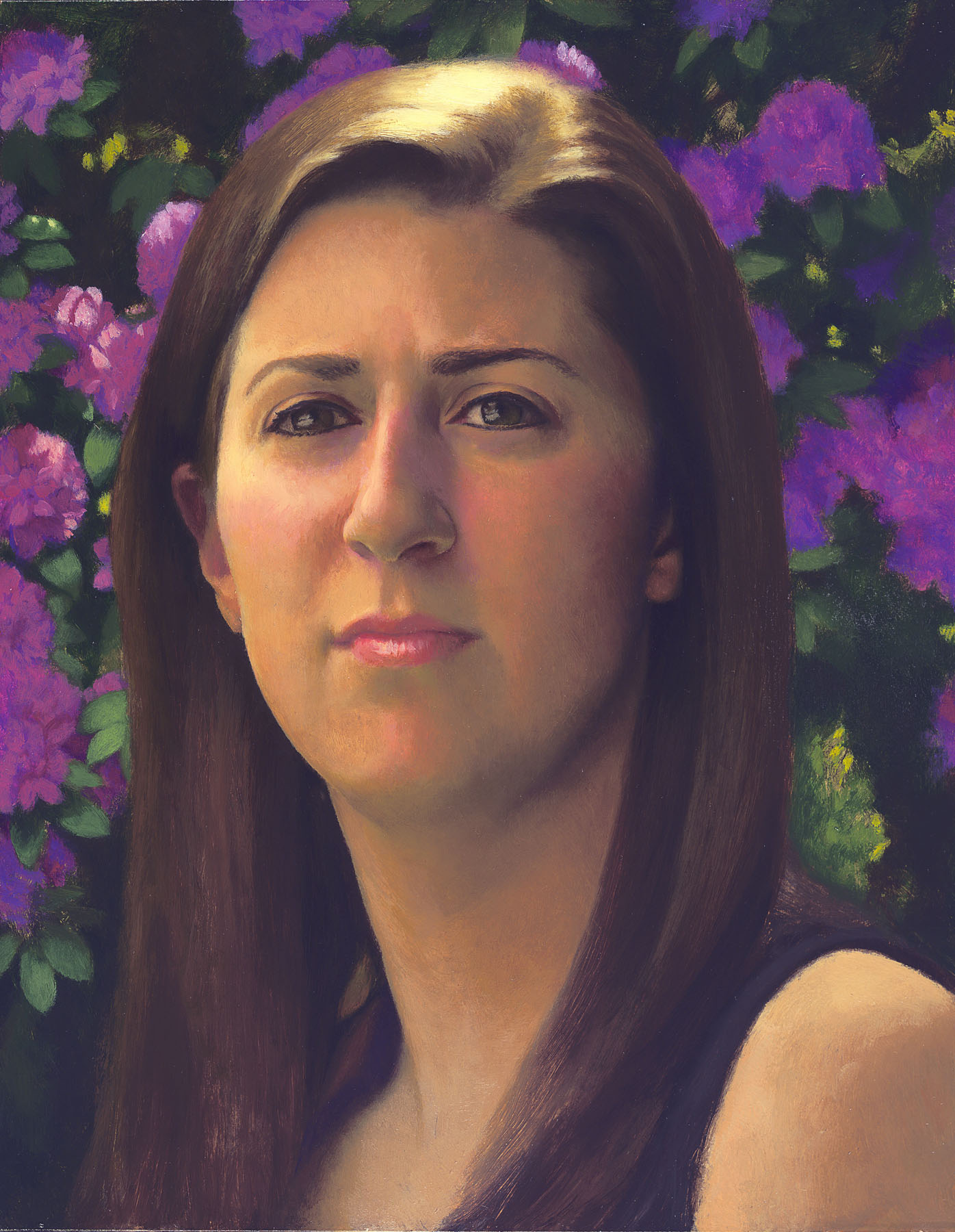By Michael Gormley

Wende Caporale, Avignon, oil on board, 16 x 20 in.
Artists often become attached to, and eventually identified with, specific motifs. Monet favored spires and haystacks; Wende Caporale conjures up images of young mothers and their children. The sweetness of youth most often comes to mind when I think of Caporale—particularly her signature pastel portraits which display a luminosity ideally suited to expressing the tender age of innocence.
So it came as a bit of a surprise to see Caporale’s entry to the recent Portraits, Inc. exhibition at the Salmagundi Art Club—not a pastel of a mother and child but a jewel of an oil painting depicting a young woman sans familial trappings. In this work, the subject gazes past the viewer, self-absorbed and isolated in her maiden beauty—like a goddess, immortal as only the young can be. The portrait’s style harkens back to Bronzino with its perfect edges, hard polished surface and closed forms that perfectly echo the brilliant shine of a life still untouched by the seeming random vagaries of fortuna. Could the loose and sketchy immediacy of pastel truly communicate this beauty’s perfect and unassailable power? I think not. Nor does Caporale; she instead capitalizes on the alchemy of oil painting and renders her subject as ideal form with imperceptible gradations of tone and color and glowing layers of translucent velvaturas.
Caporale loves form and space; inventive by nature, well trained, and ever ready to exploit a clever sense of design, she could just as easily be painting abstract patterns and decorative schemes. It follows that this diminutive painting holds the wall and feels “modern”—and here’s how. Take a close look at the background. You may experience the background as not entirely staying in the background. This is not a mistake—we call this artistic intent—code for when an artist blatantly breaks the rules. In this instance Caporale’s scrim-like floral motif advances towards the picture plane, thereby skewing perspective conventions and flattening illusionistic space. We are led to question the imagined space her finely modeled head inhabits. This is a good thing. Though our eye is initially seduced by the work’s realism, and naturally proceeds to read the work photographically, the unhinged background actively disrupts this read. Ultimately we experience the work as pure pictorial invention—as painting. This experiential distinction is significant. Achieving photo-like verisimilitude is not Caporale’s primary aim; rather she aims to set up an optical experience that communicates an aesthetic ideal. Both production aims are active in contemporary realist painting; the latter however makes art.
I like to think that “Avignon” offers another view beyond that of a beautiful young woman—I glimpse the artist’s career coming full circle.
Like many contemporary figurative artists coming of age in a world still largely enthralled with modernism’s abstractions and conceptual experiments, Caporale had opted to study illustration—which held out the promise of a good income based on the production of works that focused on traditional media and subjects. Though surely a decent career path, Caporale really didn’t have a lot of choices. Since the end of WWII and up through the nineties, “fine art” curriculums in American colleges and universities followed European pedagogical models based on modernist theory; learning to be a “figurative” or “representational” fine artist simply wasn’t an option—in fact these very terms, as post-modern descriptors, didn’t gain significant usage until well into the nineties.
As hoped, commercial illustration did provide Caporale with a considerable income—at least initially. However, changing consumer trends and allied marketing efforts led media art directors to increasingly choose photographers over illustrators when commissioning imagery. Soon there was no work. Again, Caporale found herself at odds with prevailing tastes and needing to re-invent herself (as all true artists do) as a way to move forward. Crossing over to commissioned portraiture looked promising as it required the type of representational painting techniques Caporale had perfected in her illustration work. And like illustration, Caporale knew she needed to develop a sample portfolio to demonstrate her talent to potential clients.
Then a new mother, Caporale didn’t need to venture far to find her first portrait subject; her daughter Avignon proved the ideal muse. As luck would have it, this initial subject choice was auspicious and an abundance of commissions for children’s portraits poured in—a natural by-product of the social connections engendered while raising a child in a small and tight-knit community. The rest is history and reads like a fairy tale; Caporale now ranks among our nation’s most talented portraitists and is currently represented by Portraits Inc.
For information about commissioning a portrait by Caporale or other top artists represented by Portraits, Inc. please contact us.
Michael Gormley is a painter, writer, curator and regular contributor to the Portraits, Inc. blog. Gormley is the former editor of American Artist magazine and most recently created the fine art catalog for Craftsy--an online education platform.
Portraits, Inc. was founded in 1942 in New York on Park Avenue. Over its 70-year history, Portraits, Inc. has carefully assembled a select group of the world’s foremost portrait artists offering a range of styles and prices. Recognized as the industry leader, Portraits, Inc. provides expert guidance for discerning clients interested in commissioning fine art portraits.

